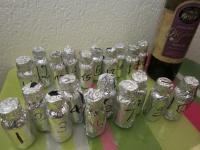I really feel that it is better if they don't know.b.) An open study where the experimenters know whether they are getting C60oo or colored olive oil. These experimenters will follow the same protocols as the closed branch of the study but will post openly in in the Longecity forum about the progress of their experiment. They will essentially be supervised by "the community",

Replicating Baati Through Community Science
#91
Posted 11 October 2012 - 08:19 PM
#92
Posted 11 October 2012 - 09:51 PM
I really feel that it is better if they don't know.b.) An open study where the experimenters know whether they are getting C60oo or colored olive oil. These experimenters will follow the same protocols as the closed branch of the study but will post openly in in the Longecity forum about the progress of their experiment. They will essentially be supervised by "the community",
thanks for sharing your opinion again. For the open part of the experiment we can ask who wants to know and who does not want to know. For those who do not want to know...we should ask them to post in their Longecity log that they promise/pledge to not wreck the experiment by ending early or switching protocol. The data we collect from the open branch of the experiment will not be as robust but it will still be interesting, as long as people stick to what they are SUPPOSED to be doing! We will have to use peer pressure/encouragement to make sure they do not deviate from protocol.
Edited by Mind, 11 October 2012 - 09:52 PM.
#93
Posted 11 October 2012 - 10:06 PM
- the best is the open test without knowing what is tested,
- then the close test without knowing what is tested,
- then the open test knowing what is tested.
For the latter, the placebo should be olive-oil rather than colored-olive-oil.
In all cases we hope that people will stick with what they are supposed to be doing, and that if they don't it is made very clear. As you indicated it is important to ask people how they want to participate so that they are comfortable with the experiment and stick to it.
Concerning the randomization I think that it is better to give a different number for each bottle as so far we are finding that there are very few interested persons who actually come, so we have no view of the distribution of the number of pets per participant. Whether the randomization should be videotaped or not is icing on the cake.
Edited by AgeVivo, 11 October 2012 - 10:11 PM.
#94
Posted 12 October 2012 - 12:26 AM
a.) A closed double blind study for pet owners and volunteers that are willing to host multiple animals in their homes. They will, at a minimum, dose the animals with C60 & placebo olive oil. Having a third group of controls who get neither C60 or placebo would be a bonus and be encouraged. So far we have Logic and Maureen Thomas (and maybe AgeVivo) who have multiple animals who could do this type of experiment. Most of the other people who have expressed interest have (or will procure) 3 to 4 rats/mice. So far it has been suggested that these experimenters get placebo only, or C60 only. I agree with this since it will be more simple for the experimenters and will reduce the chance of error. These experimenters will keep a private log under supervision of 2 Longecity appointed supervisors.
Since this is the only controlled part of the experiment, I strongly advise that each site run controls of the same species and age. This part of the experiment is being done by a small number of motivated people, and I think they can handle doing it right. I think we could develop protocols that would prevent errors; e.g. labeled cages, mouse identifiers (tags, tattoos, laundry marker...), matching codes on bottles of c60-oo/placebo.
If we do end up with placebo at one site and c60 at another, then we should at the very least match the species and ages of the animals, but also be aware that we'd be giving the scientific community a reason to not take it seriously.
#95
Posted 12 October 2012 - 07:11 PM
Edited by AgeVivo, 12 October 2012 - 07:12 PM.
#96
Posted 13 October 2012 - 10:38 AM
Niner, what did you mean? ("actives") I did not understand that paragraph. Thank you!We could have the best of both worlds if we give all the pet owners actives, and run a controlled experiment at one or two sites. Perhaps AgeVivo and Logic could run the controlled experiments? It's a big commitment, so I would understand if either of you can't do it.
#97
Posted 13 October 2012 - 06:23 PM
The Great Betrayal: Fraud in Science
480 pages; by Horace Judson; Houghton Mifflin Harcourt, New York; October 2004).
(...) Judson offers hope that science may become truly open through electronic publishing. Whether the free exchange of criticism offered by the Internet will refresh science remains to be seen (...) As for publication of research, Judson plots a distressing downward spiral in the peer review system, but holds out hope that "open review," which prevents reviewers from hiding behind anonymity, and open publication on the Internet rather than in peer-reviewed journals, may solve some of the problems. This book should have significant appeal for scientists, lawyers, and judges, and other readers interested in how the pursuit of scientific knowledge is conducted today.
Edited by AgeVivo, 13 October 2012 - 06:26 PM.
#98
Posted 13 October 2012 - 06:58 PM
Niner, what did you mean? ("actives") I did not understand that paragraph. Thank you!We could have the best of both worlds if we give all the pet owners actives, and run a controlled experiment at one or two sites. Perhaps AgeVivo and Logic could run the controlled experiments? It's a big commitment, so I would understand if either of you can't do it.
"Actives" are samples of the active compound (c60-oo), as opposed to placebos.
From Publishers Weekly and from the GRG mailing list. For those who have seen too well that hidden-science is prone to mild fraud
The Great Betrayal: Fraud in Science
480 pages; by Horace Judson; Houghton Mifflin Harcourt, New York; October 2004).
(...) Judson offers hope that science may become truly open through electronic publishing. Whether the free exchange of criticism offered by the Internet will refresh science remains to be seen (...) As for publication of research, Judson plots a distressing downward spiral in the peer review system, but holds out hope that "open review," which prevents reviewers from hiding behind anonymity, and open publication on the Internet rather than in peer-reviewed journals, may solve some of the problems. This book should have significant appeal for scientists, lawyers, and judges, and other readers interested in how the pursuit of scientific knowledge is conducted today.
This isn't talking about being open during the experiment, it's talking about being open in the peer review process, which I have rather mixed emotions about, and being open in publication, or in other words, letting people see the paper on the internet for free. I'm very much in favor of this last part.
#99
Posted 13 October 2012 - 07:07 PM
Ok, me too. I am also in favor of letting people follow and discuss the experiment online as it goes, but I undestand that's something else.letting people see the paper on the internet for free. I'm very much in favor of this last part
#100
Posted 13 October 2012 - 11:06 PM
+1
#101
Posted 14 October 2012 - 08:04 AM
That's not so obviously the case however (expectedly, or sadly, I don't know), so to have precision on the life extension degree (if any...), it does seem better if we can have both treatment and control in at least a few houses.
Edited by AgeVivo, 14 October 2012 - 08:05 AM.
#102
Posted 15 October 2012 - 06:51 AM
I hope we're not changing that now. We really really need another study as exactly like Baati's as possible but with a larger sample size. That means doing a double-blind placebo-controlled test.
The open test will be interesting, but it won't be anything anyone in science will take seriously or think of relying on.
#103
Posted 15 October 2012 - 06:55 PM
- In the hidden type of experiment, the experimenters will still create a log (just like any researcher in a lab has a logbook; format = ?) that will be followed by some Longecity persons (persons = ?; like any researcher in a lab can share with neighbors, collaborators, chief...) and in the end of the parallel experiments the logbook will be made public.
- The shared type of experiment will be like what I do with my three mice, except that experimenters will have the choice between being told or not what the treatment and solutions are.
I know several scientists who are waiting much from the open test, at least for that special feature. They believe that if researchers had ways to communicate with an interested crowd as they do their experiment, open tests would certainly be done more often and would be recognized as a high quality standard. In general what happens is that researchers do things on their own without being seen by others; it can be good in terms of free-thinking, creativity, but sometimes depressing not to be able to communicate well about ones' work, and sometimes not the best in terms of quality, especially when it comes to reproducing a result.
#104
Posted 15 October 2012 - 09:03 PM
#105
Posted 21 October 2012 - 10:17 PM
#106
Posted 22 October 2012 - 01:27 PM
If so, it is probable that I could do it. I'm also interested in the shorter term studies such as c60-OO adduct formation and the like. I have decent lab access and should be able to fund it on my own, I just need ideas and support on the knowledge side of things.
Edited by DoomAndGloom, 22 October 2012 - 01:30 PM.
#107
Posted 22 October 2012 - 02:36 PM
There should be the same dosage procedure in all experiments and we should consider feeding the mice (or rats) the same standard food. Is there some place online that sells the same species of mice or rats with verifiable ages for an affordable price?
Again, if we are only focused on one variable (not things like "My mouse has grown 2 inches more hair and seems more active!") then we would only need pictures periodically, dosing records, date of birth, date of death, and unplanned events to be posted.
DoomAndGloom, for this particular study, I am positive we want mammals only, but if you could do tests on other species of animals that would be interesting to see. I am sure everyone would like to see your results. The benefit of using flies is that they have such short life spans so you would see something way before we do in terms of longevity.
#108
Posted 22 October 2012 - 09:05 PM
- cool, the researcher told me today that he found something to improve the pacebo (colored oil). he seems very happy about it. it was good not to start too fast!!
- my main remaining concern with the current experiment design is that we said that experimenters could choose between knowing or not knowing what is treatment and placebo. I am wondering if knowing that you give placebo or treatment could change the main outcome of the experiment by a two-digit percentage?
- @doomandgloom: perhaps you should send an email to cynthia kenyon first? you'll easily find her email via any paper she published. she said she would like to test it in c elegans, I'm not sure if she has done it ( = I guess not yet). personally I think it would be a good thing to do. At least I am sure that people would be very interested in knowing the results. And once you made the test for C60, you've developed the skill and recognition to test something else later.
Edited by AgeVivo, 22 October 2012 - 09:11 PM.
#109
Posted 23 October 2012 - 12:00 AM
- @doomandgloom: perhaps you should send an email to cynthia kenyon first? you'll easily find her email via any paper she published. she said she would like to test it in c elegans, I'm not sure if she has done it ( = I guess not yet). personally I think it would be a good thing to do. At least I am sure that people would be very interested in knowing the results. And once you made the test for C60, you've developed the skill and recognition to test something else later.
Wow, is Kenyon getting involved? She's one of the most prominent aging researchers, who's often gossiped about as someone who may be up for a Nobel prize in time.
#110
Posted 23 October 2012 - 02:17 AM
Would it be at all useful to test c60-OO on Caenorhabditis elegans, Drosophila melanogaster, or Saccharomyces cerevisiae? I cannot test on vertebrates.
If so, it is probable that I could do it. I'm also interested in the shorter term studies such as c60-OO adduct formation and the like. I have decent lab access and should be able to fund it on my own, I just need ideas and support on the knowledge side of things.
I think it would be useful to know what the effect of c60-oo is on a variety of species. You could look at lifespan as well as things like effect on reproduction and development. These last two are a form of toxicity testing that hasn't been done in any species, so anything we could learn would be useful. I'm not sure how to go about dosing the animals when you're dealing with something that's not soluble in water, but that's probably been worked out by someone. I guess you just mix it with their food, whatever that might be...
On the analytical chemistry side, if you should happen to have access to an LCMS (liquid chromatograph separates the mixture into individual components, then a Mass Spectrometer determines the molecular weight of each compound), It would be interesting to know the relative abundances and speciation of the adducts. I think you would first want to saponify the triglyceride, which might best be done by some sort of lipase, but could also be done by heating in basic solution, at the risk of doing some chemistry on the C60 part. Saponification (hydrolysis of the ester bonds) would simplify the problem tremendously by removing the glycerol and associated fatty acids, giving you a far more homogeneous mixture. It would mimic what happens in vivo, as well. We'd like to know the relative amounts of free c60, and of mono, bis, and higher substituted c60s. If you have an NMR or other tools, we'd like to know the structure of one of the main adducts. The mono-adduct would be the simplest to sort out.
#111
Posted 23 October 2012 - 04:34 AM
Would it be at all useful to test c60-OO on Caenorhabditis elegans, Drosophila melanogaster, or Saccharomyces cerevisiae? I cannot test on vertebrates.
If so, it is probable that I could do it. I'm also interested in the shorter term studies such as c60-OO adduct formation and the like. I have decent lab access and should be able to fund it on my own, I just need ideas and support on the knowledge side of things.
I think this would be incredibly useful. You could test some of the variables that are speculated on here. Eg. differeent doses, dosing at different stages of life such as only giving the C60oo in the first or last third of normal lifespan, using different oils instead of olive oil, different olive oils like high vs low polyphenol oils and maybe things like C60oo's that have been mixed up different ways - heating, ultrasonic etc. Also you could try the cheaper C60/C70 mix to see if the result is the same. Lots of possibilitys.
I hope to do some of these in mice next year, however if I could have some of these eliminated beforehand, that would be excellent.
#112
Posted 24 October 2012 - 01:40 PM
http://www.nytimes.c...ie.html?hp&_r=1
The picture they took was of the subject of the article tending his garden and olive grove.
TLDR: Guy is diagnosed with terminal illness and given six months to live, moves out of the USA back to his homeland, appears to be cured and lives more than 30 years later (and is still alive.)
Basically, we cannot discount the potential of Olive Oil itself to extend lifespans significantly.
----
I was going to post it on another thread, but I decided to put it here instead simply because I thought it was interesting, and it certainly means that we should consider having Olive Oil as a possible variable in our experiment. However, with that said, these people may live longer than the life expectancy, but they are not exceeding the maximal lifespan which are two different things. We do not want our rats to live past their normal life expectancy. Instead, we want our rats to live past the natural maximal lifespan. (Because I know the human natural maximum lifespan is 120 years, I will use them as an example. It would be nice for a human to live to be 115 years old, but that is not our ultimate goal. The ultimate goal would be to have a human reach 130+ years old which would be 10 years more than the maximum lifespan if not more.)
#113
Posted 07 November 2012 - 04:00 PM
the supernatant was filtered through aMillipore filter with 0.25 micron porosity.
#114
Posted 10 November 2012 - 07:40 PM
Here is what I will propose him (I am modifying the previous post on the matter)
- Prepare
- treatment bottles on the left, placebo bottles on the right
- no label on the bottles: all indistinguishable
- *if* placebo is rapid to prepare, that could be video taped
- numbers
- 20 labels ready to be sticked in the bottle, numbered 1 to 20 (a piece of paper on a portion of tape)
- Labels wil be used in the natural order (1 to 20)
- a pen for side and cover of the bottle (to be tested first on glass/similar texture)
- computer
- zip file containing a text file describing the method to do placebo
- excel file with 20 lines numbered 1 to 20
- paper
- 2 sheets of paper, each containing a table of 20 lines and 3 columns. The fist column is numbered 1 to 20
- a pen that works
- a rolling dice
- video
- make sure that the light is ok, that batteries are ok, etc.
- treatment bottles on the left, placebo bottles on the right
- Start the video and go!
- 20 times in a row, the researcher rolls a dice
- if 1 2 or 3, stick the next label to a treatment bottle (on the left)
- if 4 5 or 6, stick the label to a placebo bottle (on the right)
- Also mark the label on the side and cover of the bottle with the pen.
- In the table (computer and 2 sheets), write "treatment" or "placebo" next to the number of the label
- if the video stops, stop all, start a new video and continue. (if video really doesn't work, then continue without video)
- 20 times in a row, the researcher rolls a dice
- Done?
- Put the excel file in the zip file and crypt it (I will post separately about how to crypt)
- Write the crypting password in the 2 sheets of paper. Both the researcher and the cameraman will keep the sheet of paper in a well securized place that they are sure to find in approx 3 years.
- Check that the file is crypted. Send it by email to smithx, niner, mind and I (be careful to send the crypted file only)
Note on the procedure:
For "how to use", we will see later as we are still in the phase of adjusting the configurations to try to have a coherent experiment (*). But the randomizing procedure described here (the video is essentially for fun) might not be the best adapted for some use but it is at least compatible with any configuration.
(*) Without many experimenters, it is difficult to have some design that is quite optimal in terms on statistical power. Different experimenters have very diverse settings (ages and gender of rats or mice) and preferences (treated hungry or not hungry animals, know or not know what is treatment and what is placebo, have either treatment or placebo or have both); we're discussing with them what would be good settings for the global experiment and that they also like.
Edited by AgeVivo, 10 November 2012 - 07:38 PM.
#115
Posted 11 November 2012 - 10:22 PM

There are 10 treatments (C60 in olive oil) and 10 placebos (colored olive oil), but I don't know the correspondance with the numbers. The researcher and cameraman told me that both really look the same but I won't remove the aluminium sheets. They have the correspondance and they will disclose it at the end of the experiment (in approx in 3 years).
Here is the randomization procedure that was used:
- Preparation
- treatment bottles on the left, placebo bottles on the right
- no label nor plastic protection on the bottles: all indistinguishable
- treatment and placebo bottles already filled
- numbers
- 20 labels ready to be sticked in the bottle, numbered 1 to 20 (a piece of paper on a portion of tape)
- a pen for side and cover of the bottle (to be tested first on glass/similar texture)
- a metal bar made to burn into the glass
- computer
- excel file attached, opened
- paper
- 2 sheets of paper, each containing a table of 20 lines and 3 columns. The fist column is numbered 1 to 20
- a pen
- video
- a camera
- Start the video and go!
- randomize: follow the instructions of the excel file
- results copied on paper
- labels taped around the bottles
- labels in addition written on side and cover of bottles
- bottles covered by aluminium and label writen on the aluminium
- Done?
- Excel file brought by the cameraman on usb key, as well as videos
- They will crypt the file and send it to caliban
- I'll ask caliban to check that the file is crypted and send it to us
Edited by AgeVivo, 11 November 2012 - 10:32 PM.
#116
Posted 22 November 2012 - 06:35 AM
=> is AES256 sufficiently secure to be put online?
=> if so, where should we tell him to put the file?
#117
Posted 22 November 2012 - 09:47 AM
If you want to be really safe, use at least a 1024 bit key. But I think for this application AES256 is fine.
Edited by smithx, 22 November 2012 - 09:50 AM.
#118
Posted 25 November 2012 - 11:53 AM
It is on 2 places:
http://www.adrive.co...ndomization.zip
https://www.dropbox....ndomization.zip
Can someone download it and let us know if it works?
#119
Posted 27 November 2012 - 03:03 AM
#120
Posted 28 November 2012 - 07:09 PM
Also tagged with one or more of these keywords: baati, c60, olive oil, pet owners, mprize@home
2 user(s) are reading this topic
0 members, 2 guests, 0 anonymous users


















































